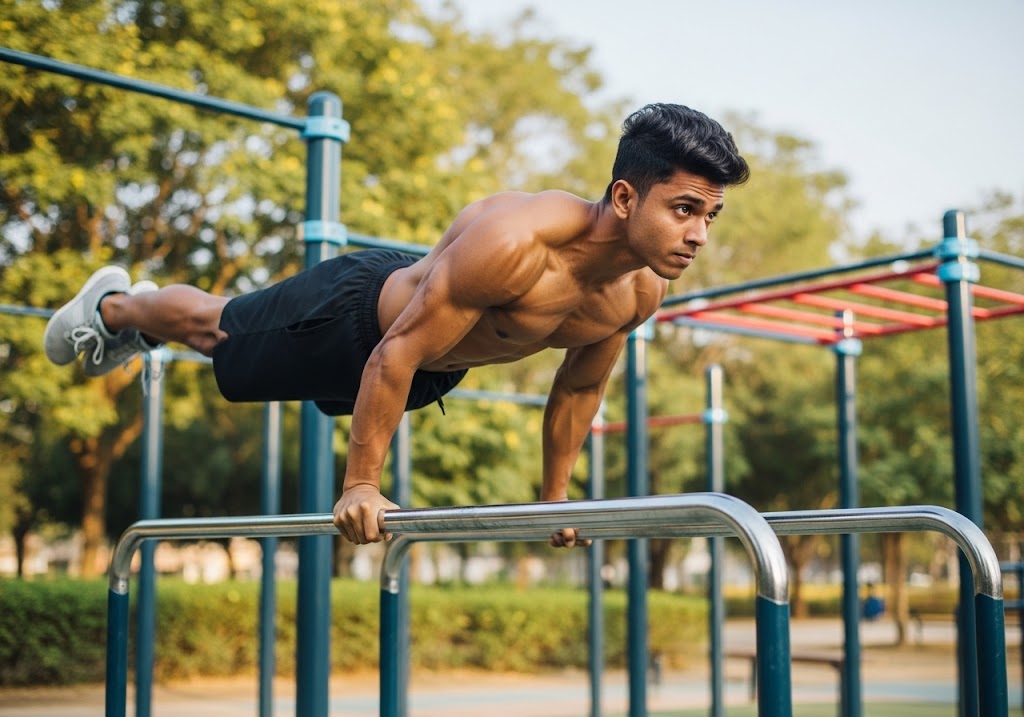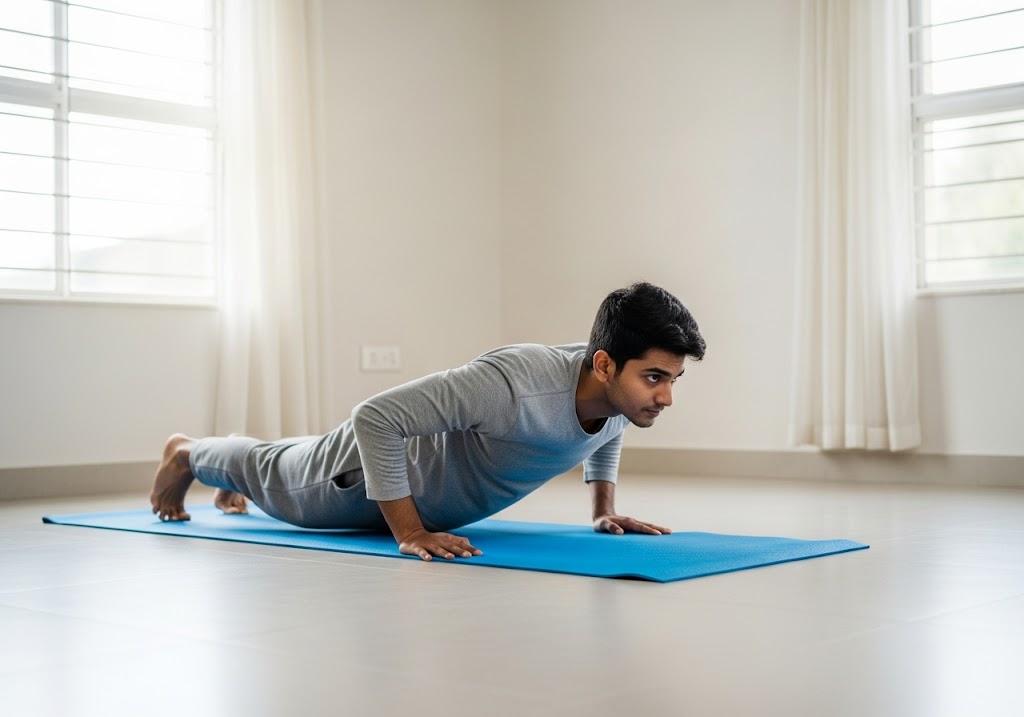Calories burned in jump squats range from 8-10 calories per minute for an average person weighing 70 kg, making this high-intensity exercise an excellent choice for fat burning and cardiovascular fitness.
Understanding exactly how many calories burned in jump squats can help you plan effective workouts and track your fitness progress. This explosive plyometric exercise combines strength training with cardiovascular benefits, making it one of the most efficient calorie-burning exercises you can perform at home or in the gym. The calories burned in jump squats significantly exceed those of regular squats due to the explosive movement pattern.
Jump squats elevate your heart rate quickly while engaging multiple large muscle groups simultaneously. The explosive jumping motion requires more energy than regular squats, significantly increasing the calories burned in jump squats compared to static versions. Whether you’re doing 10, 50, or 100 repetitions, knowing the exact calorie burn helps optimize your workout routine and maximize calories burned in jump squats per session.
This analysis covers everything from basic calorie calculations to advanced factors affecting your burn rate. You’ll learn specific numbers for different repetition ranges and discover how body weight, intensity, and technique influence calories burned in jump squats. Let’s explore the science behind this powerful exercise and discover strategies for maximizing calories burned in jump squats.
Table of Contents
Understanding Calories Burned in Jump Squats
Learning about calories burned in jump squats requires understanding the metabolic demands of this explosive exercise. Jump squats use a MET (Metabolic Equivalent of Task) value of 8.0, significantly higher than regular squats at 5.5 MET. This higher intensity directly translates to increased calorie expenditure per minute of exercise.
The basic formula for calculating calories burned in jump squats uses your body weight, exercise duration, and MET value. A person weighing 70 kg performing jump squats for 10 minutes burns approximately 98 calories using the standard metabolic equation. This makes jump squats one of the most efficient bodyweight exercises for calorie burning.
| Body Weight | 5 Minutes | 10 Minutes | 15 Minutes | 20 Minutes |
|---|---|---|---|---|
| 60 kg | 42 calories | 84 calories | 126 calories | 168 calories |
| 70 kg | 49 calories | 98 calories | 147 calories | 196 calories |
| 80 kg | 56 calories | 112 calories | 168 calories | 224 calories |
| 90 kg | 63 calories | 126 calories | 189 calories | 252 calories |
Several factors influence the actual calories burned in jump squats including your fitness level, jumping height, landing technique, and rest intervals between sets. Higher intensity jumping with minimal rest periods maximizes calorie burn while building explosive power and cardiovascular endurance.
Alternative exercises like regular squats, step-ups, or resistance band exercises for abs can provide similar benefits with lower impact for people who need modified approaches to fitness training.
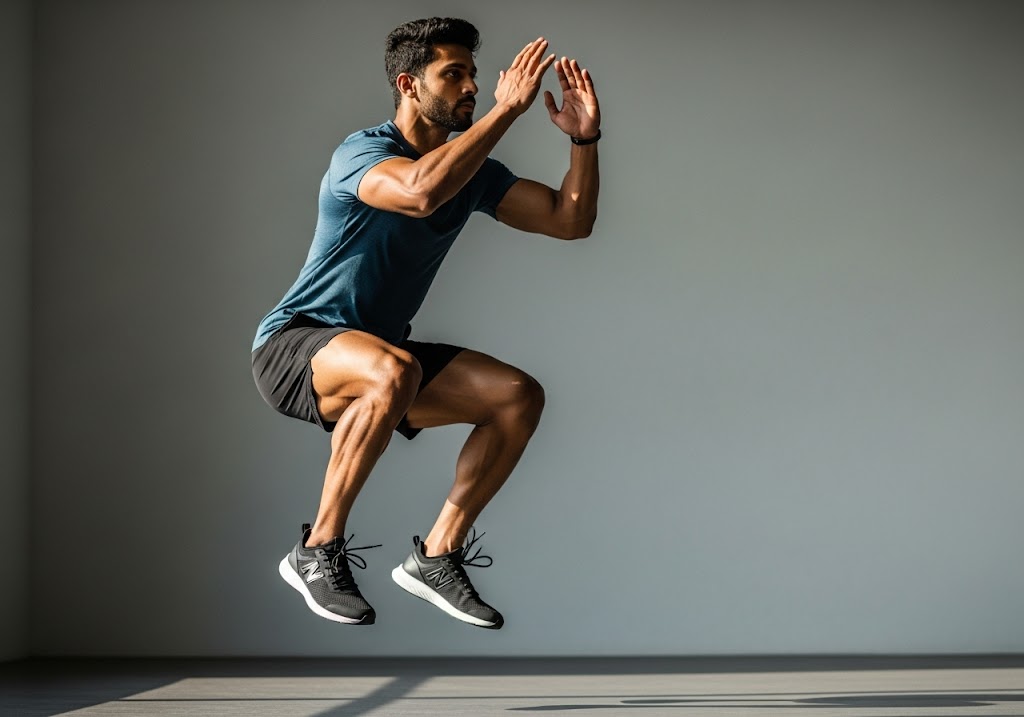
Jump Squats vs. Regular Squats: Calorie Comparison
Understanding the difference between calories burned in jump squats versus regular squats helps optimize your workout selection for maximum energy expenditure. Jump squats burn significantly more calories due to explosive movement patterns that engage more muscle fibers and elevate heart rate higher than static squatting movements.
| Exercise Type | MET Value | Calories/Min (70kg) | 10 Minutes | 20 Minutes | Intensity Level |
|---|---|---|---|---|---|
| Regular Squats | 5.5 | 6.4 | 64 | 128 | Moderate |
| Jump Squats | 8.0 | 9.3 | 93 | 186 | High |
| Weighted Squats | 6.0 | 7.0 | 70 | 140 | Moderate-High |
| Pulse Squats | 6.5 | 7.6 | 76 | 152 | Moderate-High |
| Single-leg Jump Squats | 9.0 | 10.5 | 105 | 210 | Very High |
The explosive jumping motion in jump squats recruits additional muscle fibers and requires greater oxygen consumption than static squatting movements. This increased muscular activation and cardiovascular demand directly translates to higher calorie expenditure. Jump squats also create an afterburn effect, continuing to burn calories post-exercise through elevated metabolism. Understanding these differences helps you choose the most effective exercise variation for your fitness goals and time constraints when maximizing calories burned in jump squats.
Learn more about can hiit build muscle to understand how high-intensity exercises like jump squats contribute to muscle development.
Metabolic Differences Between Squat Variations
The metabolic differences between squat variations significantly impact calories burned in jumping squats compared to standard versions. Jump squats require rapid muscle contractions followed by explosive extensions, demanding more immediate energy from both aerobic and anaerobic systems simultaneously.
| Squat Type | MET Value | Calories/Minute (70kg) | Primary Energy System |
|---|---|---|---|
| Bodyweight Squats | 5.5 | 6.4 | Aerobic + Some Anaerobic |
| Jump Squats | 8.0 | 9.3 | Anaerobic + Aerobic |
| Weighted Squats | 6.0 | 7.0 | Mixed Systems |
| Pulse Squats | 6.5 | 7.6 | Primarily Aerobic |
Exercise Intensity Impact
Exercise intensity dramatically affects calories burned in jumping squats, with higher jumping heights and faster repetition rates increasing energy expenditure. Maximum effort jump squats can elevate calorie burn to 12-15 calories per minute, while moderate-intensity versions typically burn 8-10 calories per minute for the same duration. Factors like jumping height, speed of movement, depth of squat, and explosive power output all contribute to intensity levels. Higher intensity exercise also creates greater excess post-exercise oxygen consumption (EPOC), extending calorie burn for hours after your workout concludes.
Start your journey with expert progressions in calisthenics planche-a true test of control and strength.

Factors Affecting Calorie Burn in Jumping Squats
Understanding factors affecting calorie burn in jumping squats helps optimize your workout effectiveness and achieve better results. Body weight serves as the primary factor, with heavier individuals burning more calories due to increased energy requirements for moving larger mass against gravity during explosive movements. This directly impacts the total calories burned in jump squats per session.
Intensity level significantly influences calories burned in jumping squats, determined by jumping height, speed, and effort level. Higher intensity jumping with minimal rest creates greater metabolic demands and increased calorie expenditure. Fitness level also plays a role, as trained athletes may perform more repetitions at higher intensities, though they might also be more metabolically efficient, affecting overall calories burned in jump squats calculations.
Environmental factors and technique quality also impact calories burned in jump squats, with proper form maximizing muscle activation while environmental conditions like temperature can influence metabolic rate during exercise sessions focused on maximizing calories burned in jump squats.
- Body Weight – Heavier individuals burn more calories due to increased energy demands for movement
- Exercise Intensity – Higher jumping height and faster pace increase metabolic demands significantly
- Fitness Level – Better conditioned athletes can maintain higher intensities for longer periods
- Jumping Technique – Proper form with full range of motion maximizes muscle activation and calorie burn
- Rest Intervals – Shorter rest periods maintain elevated heart rate and increase total calorie expenditure
- Environmental Factors – Temperature and altitude can influence metabolic rate during exercise
- Muscle Mass – Greater muscle mass increases baseline metabolic rate and exercise calorie burn
Learn how effective it is at trimming your waistline in will HIIT burn fat.
Body Weight Impact on Calorie Burn
Body weight impact on calorie burn creates proportional relationships where heavier individuals consistently burn more calories during jump squats. This occurs because moving greater mass requires additional energy expenditure, particularly during explosive movements like jumping.
The relationship isn’t perfectly linear due to biomechanical efficiency differences, but generally follows predictable patterns. A 90 kg person burns approximately 50% more calories than a 60 kg person performing identical jump squat routines at similar intensity levels.
Exercise Duration and Frequency Effects
Exercise duration and frequency effects compound to influence total calories burned in jumping squats over time. Longer sessions naturally burn more total calories, while frequency affects weekly calorie expenditure and metabolic adaptations that can influence burn rates.
Optimal duration for jump squat sessions typically ranges from 10-20 minutes, balancing calorie burn with recovery needs. Higher frequency training (4-5 times weekly) can increase overall calorie expenditure while improving exercise efficiency and metabolic health markers.
For complete calorie burn comparisons, check out how many jumping jacks to burn 500 calories to explore alternative high-intensity exercises.
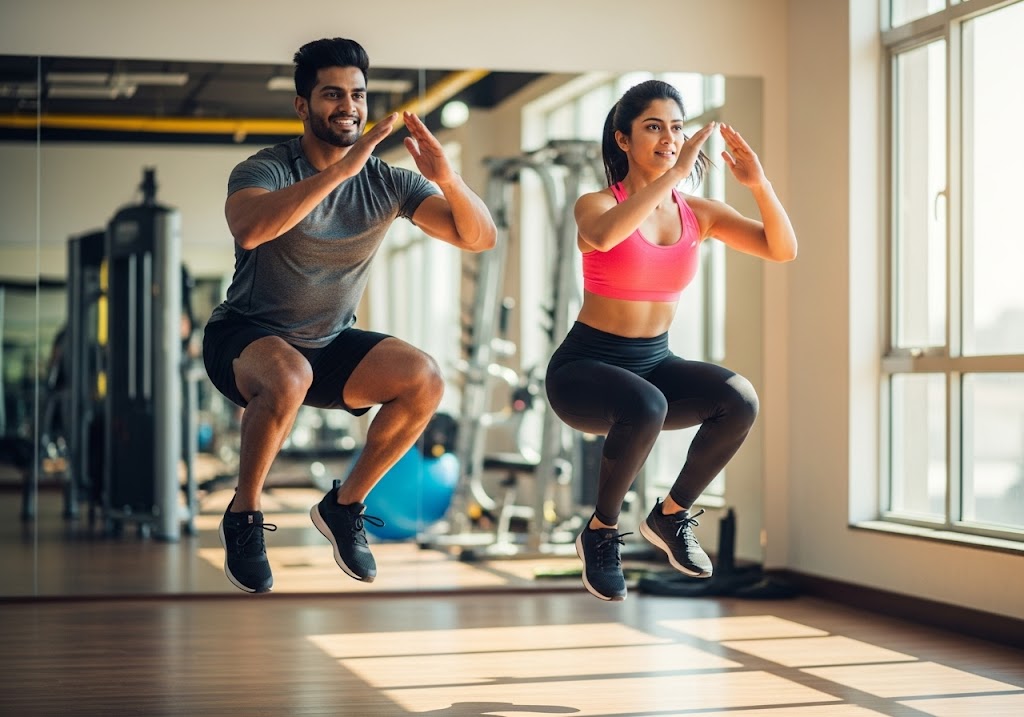
Maximizing Calorie Burn in Jumping Squats
Maximizing calorie burn in jumping squats requires strategic approach combining proper technique, appropriate intensity, and smart programming. Focus on explosive upward movement with controlled landings to maximize muscle activation while maintaining safety. Higher jumping heights and faster repetition rates increase energy expenditure significantly.
Circuit training incorporating jump squats with minimal rest between exercises keeps heart rate elevated and maximizes calorie burn per session. Combine jump squats with complementary exercises like burpees, mountain climbers, or high knees to create high-intensity interval training (HIIT) sessions that burn calories efficiently.
- Increase Jumping Height – Higher jumps require more energy and engage more muscle fibers
- Minimize Rest Periods – Keep heart rate elevated throughout your workout session
- Add Variations – Include single-leg jumps, 180-degree turns, or weighted versions for increased difficulty
- Use Circuit Training – Combine with other exercises for continuous calorie burning
- Focus on Form – Proper technique maximizes muscle activation and prevents energy waste
- Progressive Overload – Gradually increase repetitions or intensity to challenge your body
- Consistent Tempo – Maintain steady rhythm to sustain elevated heart rate throughout the session
Understanding jumping jacks exercise benefits can help you create complementary cardio routines for maximum calorie burn.
Advanced Techniques for Higher Calorie Burn
Advanced techniques for higher calorie burn involve manipulating exercise variables to increase metabolic demands. Plyometric progressions like depth jumps, box jump squats, or weighted jump squats can significantly increase calories burned in jumping squats while building explosive power.
Tabata protocols using 20 seconds maximum effort followed by 10 seconds rest for 8 rounds create intense metabolic stress that maximizes both immediate calorie burn and post-exercise metabolic elevation for extended periods.
Combining Jump Squats with Other Exercises
Creating effective exercise combinations amplifies calories burned in jump squats while targeting different muscle groups for comprehensive fitness development. Strategic pairing with complementary movements maintains elevated heart rate throughout sessions, maximizing total calorie expenditure while preventing localized muscle fatigue and enhancing overall workout effectiveness.
| Exercise Combination | Duration | Total Calories (70kg) | Primary Benefits | Difficulty Level |
|---|---|---|---|---|
| Jump Squats + Burpees | 15 min | 180-220 | Full body, high intensity | Advanced |
| Jump Squats + Mountain Climbers | 12 min | 150-180 | Cardio, core strength | Intermediate |
| Jump Squats + Push-ups | 15 min | 160-190 | Upper/lower body balance | Intermediate |
| Jump Squats + High Knees | 10 min | 120-140 | Cardio endurance | Beginner |
| Jump Squats + Jumping Jacks | 12 min | 140-170 | Total body coordination | Beginner |
| Jump Squats + Plank Hold | 15 min | 140-160 | Core stability | Intermediate |
These combinations maintain elevated heart rate while targeting different muscle groups, preventing localized fatigue while maximizing overall energy expenditure and creating more comprehensive fitness adaptations that enhance calories burned in jump squats sessions.
For complete home workout setups, explore calisthenics equipment for home options that complement your jump squat training.

How To Perform Jump Squats Correctly?
Mastering proper jump squat technique maximizes calories burned in jump squats while ensuring safety and preventing injury throughout your training sessions. Correct form involves coordinated movement patterns that optimize muscle activation, power generation, and landing mechanics for sustained high-intensity performance and long-term joint health.
| Step | Phase | Key Action | Duration | Critical Focus |
|---|---|---|---|---|
| 1 | Setup | Position feet shoulder-width apart | 2-3 sec | Stable base |
| 2 | Descent | Lower into squat position | 1-2 sec | Control and depth |
| 3 | Preparation | Engage core and prepare for jump | 0.5 sec | Power loading |
| 4 | Explosion | Jump up explosively | 0.5 sec | Maximum height |
| 5 | Landing | Land softly with bent knees | 1 sec | Impact absorption |
| 6 | Reset | Return to starting position | 1 sec | Form maintenance |
Step 1: Proper Starting Position
Establishing correct starting position forms the foundation for maximizing calories burned in jump squats while maintaining safety throughout exercise sessions. Proper foot placement and body alignment create optimal leverage for explosive power generation while protecting joints from excessive stress during repeated jumping movements.
Start in a standard squat position with feet shoulder-width apart, toes slightly pointed outward, and weight evenly distributed across both feet for optimal stability and power generation.
Step 2: Controlled Descent Phase
The controlled descent phase prepares your body for explosive jumping while ensuring proper muscle activation patterns that maximize calories burned in jump squats. Focus on maintaining proper knee tracking and hip hinge movement to optimize power output during the subsequent jumping phase.
Lower into squat position by pushing hips back and bending knees until thighs are parallel to the floor or as low as comfortable. Keep chest up, core engaged, and knees tracking over toes throughout the descent.
Step 3: Power Loading Preparation
Power loading preparation involves engaging all relevant muscle groups simultaneously to create maximum force production potential that optimizes calories burned in jump squats. This brief pause allows proper muscle activation sequencing while building tension for explosive upward movement during the jumping phase.
From the bottom position, engage your core muscles and prepare for explosive upward movement by loading your legs like springs ready to release maximum power.
Step 4: Explosive Jumping Movement
The explosive jumping movement represents the primary calorie-burning phase where maximum power output creates the highest energy expenditure during calories burned in jump squats sessions. Focus on driving through your heels while extending arms overhead for additional momentum and balance during flight phase.
Explosively drive through heels and jump as high as possible while extending arms overhead for momentum and balance. Focus on maximum height and powerful extension through legs and hips.
Step 5: Safe Landing Technique
Safe landing technique protects joints from excessive impact while maintaining exercise flow for continued calories burned in jump squats throughout your workout session. Proper landing mechanics prevent injury while preparing your body for immediate transition into the next repetition without losing momentum.
Land softly on the balls of your feet, immediately absorbing impact by bending knees and returning to squat position. This controlled landing reduces joint stress while preparing for the next repetition.
Step 6: Form Reset and Continuity
Form reset and continuity ensure consistent technique throughout longer sets while maintaining the quality movement patterns necessary for optimal calories burned in jump squats. Brief form checks between repetitions prevent technique breakdown that reduces effectiveness and increases injury risk during extended exercise sessions.
Reset your position briefly before beginning the next repetition, ensuring proper alignment and form maintenance throughout the entire set for maximum effectiveness and safety.
Check out proper techniques with our how to do jumping jacks tutorial for complementary cardio exercises.

Calories Burned in Jump Squats Per Day
Calculating calories burned in jump squats per day depends on your workout frequency, session duration, and intensity level. A typical 15-minute daily jump squat session burns approximately 147 calories for a 70 kg individual, contributing significantly to daily calorie expenditure and weight management goals.
Daily jump squat routines can range from quick 5-minute morning sessions burning 49 calories to intensive 30-minute workouts burning 294 calories. Consistency matters more than single-session intensity for long-term calorie burn and fitness improvements. Regular daily practice builds cardiovascular endurance while maintaining elevated metabolic rate throughout the day.
Consider your overall activity level and recovery needs when planning daily jump squat routines. Beginners might start with 5-10 minutes daily, while experienced exercisers can handle 15-30 minute sessions depending on intensity and other training activities. Monitor your body’s response and adjust accordingly for sustainable progress.
| Daily Session Length | Calories (60kg) | Calories (70kg) | Calories (80kg) | Weekly Total (70kg) |
|---|---|---|---|---|
| 5 minutes | 42 | 49 | 56 | 343 |
| 10 minutes | 84 | 98 | 112 | 686 |
| 15 minutes | 126 | 147 | 168 | 1,029 |
| 20 minutes | 168 | 196 | 224 | 1,372 |
| 30 minutes | 252 | 294 | 336 | 2,058 |
Planning Daily Jump Squat Routines
Planning daily jump squat routines requires balancing calorie burn goals with recovery needs and overall fitness objectives. Start with shorter sessions and gradually increase duration as your conditioning improves to prevent overuse injuries while maximizing long-term results.
Incorporate rest days or active recovery sessions using lower-intensity exercises to allow muscle recovery while maintaining movement consistency. This approach optimizes calories burned in jumping squats while supporting sustainable fitness habits.
Complementary exercises like chest and tricep workout with dumbbells can be alternated with jump squat sets to create total-body training sessions that maximize time efficiency while targeting all major muscle groups.
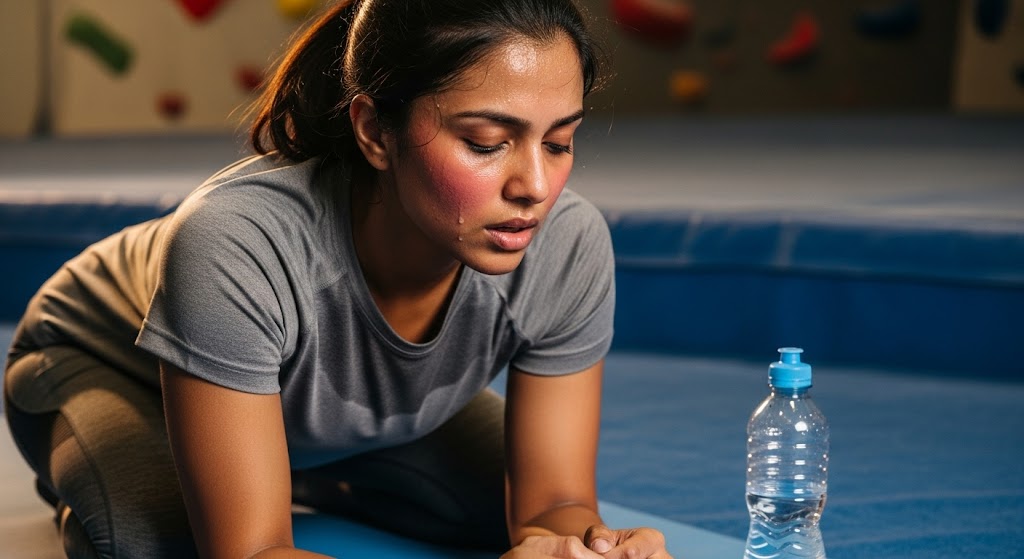
Jump Squats Calories Burned Calculator Methods
Jump squats calories burned calculator methods use scientific formulas to estimate energy expenditure based on individual characteristics and exercise parameters. The most accurate calculations incorporate body weight, exercise duration, and MET values specific to jump squat intensity levels for personalized calorie estimates.
Basic calculation formula: Calories = (MET × body weight in kg × 3.5 ÷ 200) × duration in minutes. For jump squats with MET value of 8.0, a 70 kg person exercising for 15 minutes burns: (8.0 × 70 × 3.5 ÷ 200) × 15 = 147 calories. This formula provides reliable estimates for planning and tracking purposes.
Advanced calculators may include factors like age, gender, fitness level, and heart rate data for more precise estimates. However, individual metabolism varies, so calculator results serve as helpful approximations rather than exact measurements. Track your results over time to understand your personal calorie burn patterns.
For enhanced accuracy when tracking how many jumping jacks to burn 500 calories, combine multiple exercises in your routine.
Using MET Values for Accurate Calculations
Using MET values for accurate calculations provides standardized method for estimating calories burned in jumping squats across different populations. MET values represent multiples of resting metabolic rate, with jump squats typically rated at 8.0 MET for vigorous intensity exercise.
Higher intensity jump squats may reach 10.0-12.0 MET values when performed at maximum effort with minimal rest intervals. These elevated MET values significantly increase calorie burn calculations and reflect the true metabolic demands of high-intensity plyometric exercise.
Factors Affecting Calculator Accuracy
Factors affecting calculator accuracy include individual metabolic efficiency, exercise technique quality, and environmental conditions during exercise. Calculators provide population averages that may not perfectly match individual responses to jump squat exercises.
Personal factors like muscle mass, training status, and genetic variations in metabolic rate can influence actual calories burned by ±20-30% compared to calculator estimates. Use calculations as guidelines while monitoring personal results and adjusting expectations based on individual response patterns.
Discover does calisthenics increase height to understand additional benefits of bodyweight training beyond calorie burning.

Specific Repetition Calorie Burns
Understanding specific repetition calorie burns helps track progress and plan effective workout sessions based on your available time and energy goals. Individual jump squat repetitions burn approximately 0.5-0.8 calories depending on body weight, jumping height, and execution speed for average-sized individuals.
These specific numbers allow precise workout planning whether you’re completing quick 20-rep sets or longer 100-rep challenges. Calorie burn per repetition increases with body weight and exercise intensity, making heavier individuals and higher-intensity efforts more metabolically demanding per movement.
How Many Jump Squats to Burn 500 Calories?
Calculating how many jump squats to burn 500 calories requires understanding individual calorie burn rates and sustainable exercise intensity. For a 70 kg person burning approximately 9.3 calories per minute, reaching 500 calories requires about 54 minutes of continuous jump squats.
This translates to approximately 1,350-1,620 jump squats depending on repetition rate and rest intervals. Most people cannot perform jump squats continuously for 54 minutes, so practical approaches involve interval training or combining jump squats with other exercises throughout the day.
Breaking this into manageable sessions like 3-4 separate 15-minute workouts throughout the day makes 500-calorie burn goals more achievable while allowing adequate recovery between sessions.
Build upper body strength with calisthenics chest exercises to balance your lower body focus from jump squats.
50 Squats Burn How Many Calories
Understanding calorie expenditure for 50-repetition sets helps plan effective workout sessions with specific energy targets. The difference between regular squats and jump squats becomes particularly evident at this volume, with calories burned in jump squats significantly exceeding static versions for equivalent repetition counts and time investment.
| Exercise Type | Body Weight | Estimated Time | Calories Burned | Intensity Level | Heart Rate Impact |
|---|---|---|---|---|---|
| 50 Regular Squats (60kg) | 60 kg | 3-4 minutes | 16-20 | Moderate | Low-Medium |
| 50 Jump Squats (60kg) | 60 kg | 3-4 minutes | 25-30 | High | High |
| 50 Regular Squats (70kg) | 70 kg | 3-4 minutes | 18-23 | Moderate | Low-Medium |
| 50 Jump Squats (70kg) | 70 kg | 3-4 minutes | 30-35 | High | High |
| 50 Regular Squats (80kg) | 80 kg | 3-4 minutes | 21-26 | Moderate | Low-Medium |
| 50 Jump Squats (80kg) | 80 kg | 3-4 minutes | 35-42 | High | High |
A 70 kg person performing 50 jump squats at moderate intensity burns roughly 32 calories, taking approximately 3-4 minutes to complete with brief rest periods between sets. This makes 50 jump squats an excellent quick calorie-burning option for busy schedules.
For additional strength training options, explore arm workouts with dumbbells women’s to complement your lower body training.
30 Jump Squats Calories Burned
Analyzing calories burned in jump squats for 30-repetition sets provides insight into shorter, high-intensity exercise sessions perfect for busy lifestyles. This manageable volume delivers meaningful calorie expenditure while remaining achievable for most fitness levels, making it ideal for regular daily exercise habits.
| Body Weight | Exercise Time | Calories Burned | Equivalent Activities | Recovery Time Needed |
|---|---|---|---|---|
| 55 kg | 2-2.5 minutes | 16-20 | 3 min walking | 30-45 seconds |
| 60 kg | 2-2.5 minutes | 18-22 | 3.5 min walking | 30-45 seconds |
| 65 kg | 2-2.5 minutes | 20-24 | 4 min walking | 45-60 seconds |
| 70 kg | 2.5-3 minutes | 22-26 | 4.5 min walking | 45-60 seconds |
| 75 kg | 2.5-3 minutes | 24-28 | 5 min walking | 60-75 seconds |
| 80 kg | 2.5-3 minutes | 26-30 | 5.5 min walking | 60-75 seconds |
Thirty jump squats typically take 2-3 minutes to complete with proper form and brief rest periods, burning approximately 18-24 calories for a 70 kg individual. This makes 30 jump squats an excellent option for quick energy boosts throughout the day.
Strengthen supporting muscles with how to do glute bridge exercises to improve your jump squat power and stability.
10 Jump Squats Calories Burned
Even brief 10-repetition sets demonstrate the efficiency of calories burned in jump squats for quick metabolic stimulation throughout busy days. These micro-workouts require minimal time commitment while providing meaningful energy expenditure and can be performed multiple times daily without significant fatigue or scheduling challenges.
| Body Weight | Exercise Duration | Calories Burned | Hourly Rate if Repeated | Daily Potential (10 sets) |
|---|---|---|---|---|
| 55 kg | 30-40 seconds | 5-6 | 450-540 cal/hour | 50-60 calories |
| 60 kg | 30-40 seconds | 6-7 | 540-630 cal/hour | 60-70 calories |
| 65 kg | 35-45 seconds | 6-8 | 480-640 cal/hour | 60-80 calories |
| 70 kg | 35-45 seconds | 7-8 | 560-640 cal/hour | 70-80 calories |
| 75 kg | 35-45 seconds | 7-9 | 600-720 cal/hour | 70-90 calories |
| 80 kg | 40-50 seconds | 8-10 | 580-720 cal/hour | 80-100 calories |
Ten jump squats burn approximately 6-8 calories for a 70 kg person, taking roughly 30-45 seconds to complete with proper form and controlled movement. This approach particularly benefits office workers or people with sedentary lifestyles.
Learn advanced shoulder movements with how to do arnold press to add upper body variety to your workout routine.
20 Jump Squats Calories Burned
Twenty-repetition sets represent an optimal balance between meaningful calories burned in jump squats and manageable exercise duration for busy schedules. This volume provides substantial metabolic stimulation while remaining brief enough for multiple daily sessions, making it perfect for consistent exercise habits and sustained energy throughout the day.
| Body Weight | Time to Complete | Calories Burned | Metabolic Boost | Recommended Daily Sets |
|---|---|---|---|---|
| 55 kg | 1-1.25 minutes | 10-12 | Medium | 6-8 sets |
| 60 kg | 1-1.25 minutes | 11-13 | Medium | 6-8 sets |
| 65 kg | 1-1.5 minutes | 12-14 | Medium-High | 5-7 sets |
| 70 kg | 1-1.5 minutes | 13-15 | Medium-High | 5-7 sets |
| 75 kg | 1.25-1.5 minutes | 14-16 | High | 5-6 sets |
| 80 kg | 1.25-1.75 minutes | 15-18 | High | 4-6 sets |
Twenty jump squats burn approximately 12-16 calories for a 70 kg individual, requiring about 1-1.5 minutes to complete with proper form. This duration provides meaningful calorie burn while being brief enough to perform multiple times daily.
Complement your training with resistance band exercises for abs to strengthen your core for better jump performance.
100 Jump Squats Calories Burned
Completing 100-repetition sessions represents a significant fitness challenge that maximizes calories burned in jump squats while building substantial lower body strength and cardiovascular endurance. This volume provides excellent workout intensity for experienced exercisers seeking comprehensive training sessions within relatively short timeframes.
| Body Weight | Total Time | Calories Burned | Sets Structure | Rest Needed | Fitness Level |
|---|---|---|---|---|---|
| 55 kg | 8-10 minutes | 45-55 | 4×25 or 5×20 | 60-90 sec | Intermediate+ |
| 60 kg | 8-10 minutes | 50-60 | 4×25 or 5×20 | 60-90 sec | Intermediate+ |
| 65 kg | 8-12 minutes | 55-65 | 4×25 or 5×20 | 60-90 sec | Intermediate+ |
| 70 kg | 10-12 minutes | 60-70 | 4×25 or 5×20 | 60-90 sec | Intermediate+ |
| 75 kg | 10-12 minutes | 65-75 | 4×25 or 5×20 | 90 sec | Advanced |
| 80 kg | 10-14 minutes | 70-85 | 4×25 or 5×20 | 90 sec | Advanced |
One hundred jump squats burn approximately 50-80 calories for a 70 kg person, depending on execution speed, rest intervals, and individual metabolic factors. Most people find 100 jump squats challenging but achievable when broken into manageable sets.
For comprehensive fitness routines, explore our calisthenics ab workout to complement your jump squat sessions.
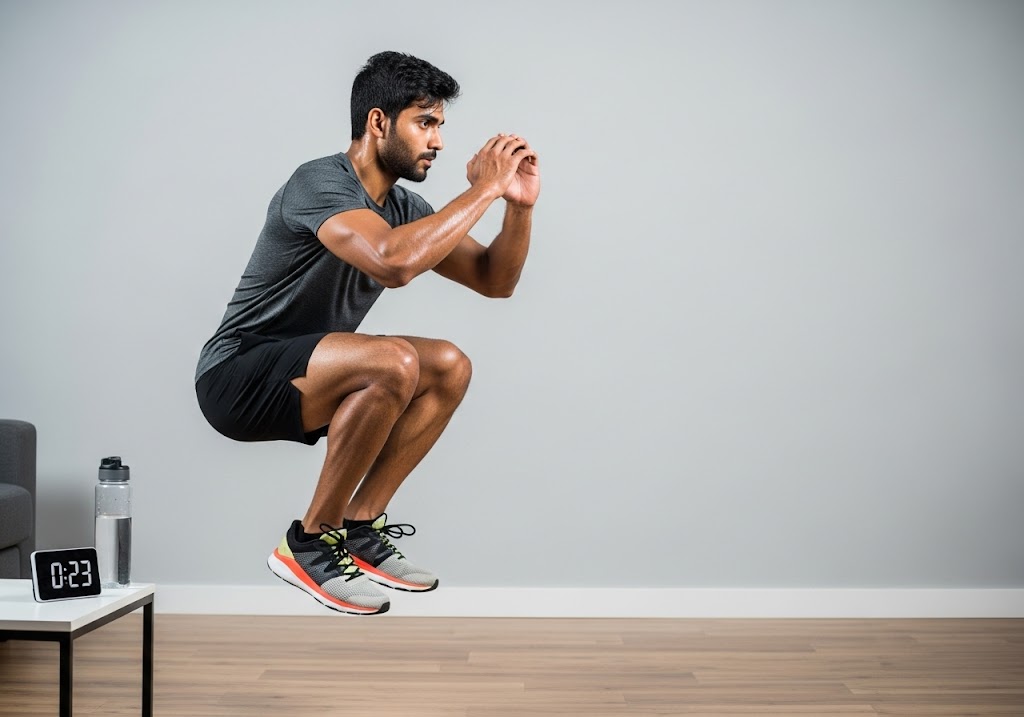
Benefits Beyond Calorie Burning in Jump Squats
While calories burned in jump squats provide immediate fitness benefits, this exercise delivers comprehensive health improvements that extend far beyond energy expenditure. Understanding these additional advantages helps appreciate the full value of incorporating jump squats into regular exercise routines for long-term wellness and performance enhancement.
Jump squats provide extensive benefits beyond calories burned in jumping squats:
- Explosive Power Development – Builds fast-twitch muscle fibers essential for athletic performance and daily functional movements
- Enhanced Cardiovascular Fitness – Elevates heart rate rapidly, improving cardiac efficiency and aerobic capacity over time
- Increased Bone Density – High-impact loading strengthens bones and reduces osteoporosis risk through mechanical stress
- Improved Neuromuscular Coordination – Complex movement patterns enhance balance, proprioception, and reaction time significantly
- Functional Strength Building – Develops practical strength that transfers to daily activities like climbing stairs and lifting objects
- Enhanced Metabolic Flexibility – Improves body’s ability to efficiently switch between different energy systems during various activities
- Elevated Mood and Mental Health – Releases endorphins during high-intensity exercise, reducing stress and improving overall wellbeing
- Better Insulin Sensitivity – High-intensity exercise improves glucose metabolism and blood sugar regulation for metabolic health
- Increased Muscle Mass – Builds lean muscle tissue in legs and core, supporting long-term metabolic rate enhancement
- Improved Athletic Performance – Develops jumping ability, speed, and agility crucial for various sports and physical activities
Understanding jumping jacks exercise benefits can help you create complementary cardio routines for maximum calorie burn.
Safety Considerations and Precautions
Safety considerations for maximizing calories burned in jumping squats include proper warm-up protocols, appropriate progression, and recognition of fatigue signs that indicate rest needs. Always begin with 5-10 minutes of light cardio and dynamic stretching to prepare muscles and joints for explosive movements.
Start with lower repetition numbers and gradually increase volume as your conditioning and technique improve. Beginners should focus on mastering landing mechanics before pursuing higher intensity or longer duration sessions to prevent injury while building confidence.
- Proper Warm-up – Include 5-10 minutes of light cardio and dynamic stretching before jump squats
- Appropriate Footwear – Wear supportive athletic shoes with good shock absorption for safe landings
- Suitable Surface – Exercise on non-slip surfaces with adequate cushioning to reduce joint impact
- Progressive Training – Gradually increase repetitions and intensity to allow adaptation and prevent overuse
- Form Priority – Never sacrifice proper technique for higher repetition numbers or faster pace
- Rest and Recovery – Allow adequate recovery between sessions to prevent fatigue-related injuries
- Stop When Tired – End exercise when form begins to deteriorate due to fatigue
Learn about what is foam rolling for effective post-exercise recovery techniques.
Injury Prevention Strategies
Injury prevention strategies focus on maintaining proper form throughout all phases of jump squat execution while recognizing personal limitations and fatigue signs. Never compromise landing technique for higher repetition counts, as poor landing mechanics significantly increase injury risk.
Monitor your body’s signals and reduce intensity or stop exercising when experiencing unusual pain, excessive fatigue, or form breakdown. Building exercise tolerance gradually prevents overuse injuries while ensuring long-term exercise sustainability.
When to Modify or Avoid Jump Squats
Situations requiring modification or avoidance of jump squats include acute injuries, joint problems, or cardiovascular conditions that contraindicate high-intensity exercise. Consult healthcare providers before beginning any new exercise program, especially if you have existing health conditions.
Explore upper body training options with chest and tricep workout with dumbbells to create balanced workout routines.
Creating Effective Jump Squat Workouts
Creating effective jump squat workouts requires balancing calories burned in jumping squats with recovery needs, progression principles, and complementary exercises for comprehensive fitness development. Structure sessions with proper warm-up, main exercise phase, and cool-down to optimize results while preventing injury.
Design workout progressions that gradually increase challenge through higher repetitions, longer durations, or advanced variations like single-leg jump squats or weighted versions. This progressive approach ensures continued adaptation while maintaining safety and sustainability for long-term success.
Incorporate jump squats into broader fitness routines rather than relying solely on single-exercise sessions. Combine with upper body exercises, core training, and flexibility work for balanced physical development that supports overall health and performance goals.
Consider using our bodybuilding exercises at home routines to complement your jump squat training for complete fitness development.
Sample Workout Routines
Structured workout routines optimize calories burned in jump squats through progressive training protocols that accommodate different fitness levels and time availability. These sample routines provide practical frameworks for incorporating jump squats effectively while ensuring appropriate progression, recovery, and sustainable long-term development for consistent results.
| Fitness Level | Routine Structure | Duration | Sets x Reps | Rest Between Sets | Estimated Calories (70kg) |
|---|---|---|---|---|---|
| Beginner | Basic Jump Squats | 12 min | 3 x 10-15 | 90 seconds | 85-100 |
| Beginner Plus | Jump Squat + Rest | 15 min | 4 x 12-18 | 60 seconds | 110-130 |
| Intermediate | Circuit Training | 18 min | 5 x 20-25 | 45 seconds | 140-170 |
| Intermediate Plus | HIIT Protocol | 20 min | 6 x 25-30 | 30 seconds | 160-200 |
| Advanced | High Volume | 25 min | 8 x 30-40 | 30 seconds | 200-250 |
| Expert | Competition Prep | 30 min | 10 x 35-50 | 20 seconds | 240-300 |
Sample workout routines demonstrate practical applications of calories burned in jump squats training for different fitness levels and time constraints. Beginner routines focus on proper form and gradual adaptation, while advanced protocols maximize intensity and metabolic stress for experienced practitioners.
Learn proper form techniques with how to do plank exercise to strengthen your core for better jump squat performance.
Integration with Other Exercises
Integration with other exercises amplifies the benefits of calories burned in jumping squats while creating more comprehensive fitness routines. Popular combinations include upper body exercises during rest periods, creating circuit training that maintains elevated heart rate throughout sessions.
Explore the advantages of both moves in push ups vs bench press and decide what aligns better with your strength goals.
Conclusion
Understanding calories burned in jump squats empowers you to make informed decisions about exercise selection and workout planning for optimal results. This explosive exercise burns 8-10 calories per minute while providing comprehensive lower body strengthening and cardiovascular benefits that extend far beyond simple calorie expenditure. The specific calorie burn numbers for different repetition ranges help you plan effective sessions whether you have 5 minutes or 30 minutes available for exercise. Remember that consistency matters more than perfect numbers, and even brief jump squat sessions contribute meaningfully to daily calorie burn and overall fitness development when performed regularly with proper form and appropriate progression.
Enhance your training variety with how to lift heavier weights principles and explore upper body movements like calisthenics close grip pull ups for balanced development, while calisthenics wide grip pull ups can complement your lower body training for complete fitness programming.
Want to master the calisthenics handstand and take your skills to the next level? Whether you’re a beginner or pushing advanced skills, ISC – Indian School of Calisthenics offers expert guidance to help you master bodyweight training. Visit us at SRPF Ground, NH8, Goregaon (E), Mumbai – 400065. For class schedules, personalized coaching, or more details, call +91 77159 53218. Train smart, move better, and unlock your back strength with ISC.
Calories Burned in Jump Squats? – FAQs
How many calories are burned in jump squats per minute?
Jump squats burn approximately 8-10 calories per minute for a 70 kg person at moderate to high intensity.
What factors affect calories burned in jumping squats the most?
Body weight, exercise intensity, jumping height, and rest intervals are the primary factors affecting calorie burn rates.
How many calories does 100 jump squats burn?
One hundred jump squats burn approximately 50-80 calories depending on body weight, intensity, and execution speed.
Are calories burned in jump squats higher than regular squats?
Yes, jump squats burn 60-70% more calories than regular squats due to explosive movement and higher intensity.
How long should I do jump squats to burn 100 calories?
A 70 kg person needs approximately 10-12 minutes of jump squats to burn 100 calories at moderate intensity.
What’s the difference between calories burned in jumping squats vs other exercises?
Jump squats burn more calories than most bodyweight exercises but less than running or cycling at similar intensity levels.
How many jump squats equal 500 calories burned?
Approximately 1,350-1,620 jump squats are needed to burn 500 calories, typically requiring 50-60 minutes total exercise time.
Do heavier people burn more calories in jump squats?
Yes, heavier individuals burn more calories in jump squats because moving greater body weight requires more energy.
How many calories do 30 jump squats burn?
Thirty jump squats burn approximately 18-24 calories for a 70 kg person, taking 2-3 minutes to complete.
Can jump squats burn enough calories for weight loss?
Jump squats can contribute significantly to weight loss when combined with proper diet and other exercises in a complete fitness program.
